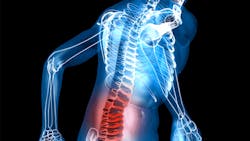MSDs are one of the most common causes of severe long-term pain and physical disability in America. Many workers who have surgery for a musculoskeletal disorder experience recurring problems that require additional surgery, leading to lost work time, disability and required changes in occupations.
From 2010 to 2011, we saw a relatively unchanged rate of nonfatal occupational injury and illness cases requiring days away from work. Although this number remained statistically the same, there was an increase in musculoskeletal disorders (MSDs), from 29 percent of all workplace injuries and illnesses in 2010 to 33 percent in 2011. Within that 33 percent, six occupations accounted for 26 percent of the MSDs:
- Nursing assistants
- Laborers
- Janitors and cleaners
- Heavy and tractor-trailer truck drivers
- Registered nurses
- Stock clerks
So if lost workday injury rates are basically stationary, why have MDSs increased?
These injuries are not necessarily the result of an instantaneous or acute event; instead, they reflect a more gradual, chronic development. They are injuries to the muscles, nerves, tendons, ligaments, joints, cartilage or spinal disc. Whether a worker sits at a desk, provides bedside care in a hospital, drives a truck or works on a production line, he or she is at risk of developing an MSD. Many people develop MSDs because they continue to do their jobs regardless of the correct posture or proper way the task should be done.
To help eliminate or reduce MSDs, workers and EHS professionals should be aware of the following six ergonomic risk factors:
- Force
- Contact stress
- Vibration
- Cold (extreme temperatures)
- Awkward posture
- Repetitive motion
Just “getting the job done” should not be the workers’ primary goal. Instead, the focus should be on getting the job done in the safest way possible.
Performing a job “incorrectly” is actually not as difficult as one might think. Are employees lifting in the proper manner? While typing, are their wrists resting down on the table, causing contact stress? Taking the time to focus on safety training and preventative care can help workers and employers avoid unnecessary pain and expenses.


